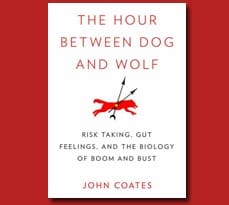New book by Dr John Coates looks at how the body reacts to risk taking in the financial world
 Dr John Coates, a Senior Research Fellow at Cambridge Judge Business School and former Wall Street trader, has recently published a book that looks at the biology of people under stress, such as a Wall Street trader, and reveals that the way their body reacts when taking a financial risk, is the same as an Olympic athlete would experience when preparing for a big race. The book is now being released in Australia and India.
Dr John Coates, a Senior Research Fellow at Cambridge Judge Business School and former Wall Street trader, has recently published a book that looks at the biology of people under stress, such as a Wall Street trader, and reveals that the way their body reacts when taking a financial risk, is the same as an Olympic athlete would experience when preparing for a big race. The book is now being released in Australia and India.
In The Hour Between Dog and Wolf: Risk-taking, Gut Feelings and the Biology of Boom and Bust, Dr Coates describes the high-pressure world of Wall Street by telling a story of fictional traders as they are caught up in a bubble and then a crash. As the characters succumb to irrational exuberance and then pessimism, Dr Coates looks inside their bodies to describe the physiology driving their behaviour.
The result is a riveting tale and a penetrating insight into how traders’ – and indeed any human’s – bodies guide their risk taking, endowing them with fast reactions and gut feelings; but how occasionally their biology can drive them to extremes of euphoria or anxiety and stress, and thereby wreak havoc on the economy.
Dr Coates explains that tried and tested research pointed the finger towards the ‘molecule of irrational exuberance’ – the chemical that causes traders, during a bubble or a winning streak, to take too much risk.
A robust animal behaviour model, the ‘winner effect’, was applied, and research showed that rising levels of testosterone drove that animal to take more risks, become more confident, increase its haemoglobin and therefore step up oxygen content in the blood. Dr Coates concluded that the ‘winner effect’ was known to exist in humans, in particular athletes, and is identified in city traders too. He believes that risk managers should ‘coach’ their traders like athletes, rather than just supervising them and even force them to take ‘rain’ breaks like tennis players at Wimbledon, until their biology resets.
Dr Coates also goes on to look at what happens to the bodies of traders when the crash comes, with its increased volatility and losses. He says:
The resulting uncertainty triggers fatigue, chronic stress and a debilitating condition known as ‘learned helplessness’. Financial risk taking, it turns out, is as much a physical activity as facing down a grizzly bear, with as many medical consequences.”
It is in this part of the book that Dr Coates extends his analysis of the biology of risk taking into other worlds and argues that workplace stress is one of the main sources of illness. He concludes by surveying research on how physiological toughening regimes can help us build up resilience to exuberance, fatigue, and stress and suggests how managers can help reduce stress in the workplace.
The book, which was published in June by Random House in Canada, Penguin in the US and Harper Collins in the UK and English language Europe, has been serialised by the New York Times, and Time Magazine, is already a Bloomberg Top Business Book and has featured in CNBC’s 12 Business Books for 2012. It is being published in the Australia and India by Harper Collins. Dr Coates has recently had an offer for Korean rights and has also sold the rights to Spain, Japan, China and Taiwan. It has received a host of positive reviews from a number of leading publications:
“Brilliant….Coates has a gift for vivid description… This book should be top of the summer reading list for Jamie Dimon, chief executive of JPMorgan, and anyone else wondering why traders so often get banks into trouble.” (Financial Times)
“Using physiology and neuroscience, and grounded by twelve years working in New York’s financial district, Coates paints a vivid picture of stockbrokers as thrill junkies, surfing waves of boom and bust on steroid hormones… Vibrant.” (Nature)
“It makes intuitive sense that biological responses inform the mood of the markets. This book puts flesh on that idea.” (The Economist)
“Stunning research.” (Forbes)
“A highly speculative and profoundly unconventional book. It’s also so absorbing that I wound up reading it twice and taking copious notes. Coates’s theory carries profound implications for our understanding of economics and market stability.” (Bloomberg)
“A compelling narrative of the links between biology and the trading floor. It’s one of the most intriguing books I’ve read in a long time.” (Reading the Markets)

